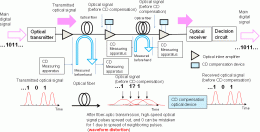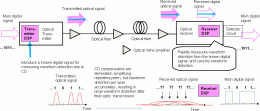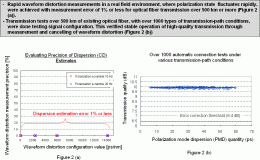First implementation of 100 and 40Gbps ultra-high-speed plug-and-play optical communications

Nippon Telegraph and Telephone Corporation and NTT Communications Corporation have conducted 100 and 40Gbps transmission tests in real field environments using existing installed optical fiber, and have demonstrated for the first time, plug-and-play functionality that greatly reduces the setup time previously required for configuring optical signals. This was achieved using a new technology developed by NTT which is able to auto-configure 100 and 40 Gbps ultra-high-speed signals.
This research result enables 100 and 40 Gbps ultra-high-speed signals to be configured easily and automatically, similarly to the 1 Gbps-class signals used for fiber-to-the-home (FTTH). It has been difficult to configure such signals immediately till now. This type of ultra-high-speed plug-and-play functionality, operating in 50 ms or less, will simplify network operations and maintenance and dramatically improve the speed of optical signal recovery when faults occur.

With the recent rapid adoption of broadband access that is accompanying the spread of FTTH and smartphones, communications traffic continues to increase by about 20% per year. This is creating demand to further reduce costs and increase the capacity of the optical core network, while maintaining its reliability as infrastructure for communications. In the past, NTT Com has always taken a leading role in introducing the latest optical communications technology and implementing an advanced core optical network to accommodate this level of increase in communications traffic and to provide highly reliable and economical broadband services to customers.
To provide even better broadband services, NTT has been advancing R&D on digital coherent technology, an advanced technology able to increase the capacity of next-generation optical networks dramatically.
In the past, optical signals with ON and OFF corresponding to one and zero of the digital signal were sent over optical fiber for fiber-optic communications. However, to transmit an ultra-high-speed signal of 100 or 40 Gbps (equivalent to sending 2 h of high definition video in 2 s) using this method, the waveform distortion added to the optical signal during transmission through the optical fiber must be measured and the system configured to remove it. Performing such preliminary measurements requires several days, and configuring equipment to eliminate the distortion also takes time.
Digital coherent technology, which is a key next-generation technology for increasing capacity, is expected to help reduce configuration time and ensure stable operation in practical operating environments, further improving network operation and maintenance and enhancing the reliability of the core optical network.
The newly developed technology is an application of digital coherent technology, which transmits an optical signal with lightwave characteristics (optical phase and polarization) corresponding to ones and zeros of the digital signal. It implements high-speed configuration for the ultra-high-speed signal by applying a new DSP function to the digital coherent technology. A DSP in the optical transmitter first introduces a known digital signal into the transmitted optical signal to measure waveform distortion beforehand, and this is transmitted as a digital coherent optical signal using lightwave characteristics. The receiver then receives optical signal, having been distorted by the unique transmission characteristics of the optical fiber, and it is digitized in real time, as-is, by the receiver DSP, making it available for high-speed digital signal processing. Specifically, the receiver DSP measures the waveform distortion added to the received optical signal directly and accurately by extracting the known signal from it, and later removes this measured waveform distortion from the received signal. The new technology measures the waveform distortion quickly and reduces configuration time to allow high-speed removal of the distortion. Both of these were difficult to implement with earlier optical communication methods using binary optical signals. NTT has successfully developed this DSP technology able to configure for 40 or 100 Gbps operation on a single wavelength automatically, within an extremely short time (50 ms or less), without human intervention.

To apply DSP in a practical optical network, it must be able to handle any waveform distortion possible in the anticipated operating environments and must have adequate processing capability to respond quickly relative to changes in waveform distortion occurring in the optical fiber. In cooperation with NTT, NTT Com tested DSP circuit performance in this way for all manner of transmission environments, devised a procedure to verify the response characteristics, and built a field-test system spanning 580 km (with average transmission path polarization mode dispersion of 35.5 ps) using its own installed commercial fiber.
To study the state of optical signal communication, 11 wavelengths with 100 or 40 Gbps signals per wavelength were transmitted under over 1000 different artificially-created transmission conditions, in field tests spanning 580 km. The results confirmed extremely stable automatic configuration in all cases. Simulating various conditions provided evidence that the technology would be able to maintain the quality of the main signal under all conditions of installed fiber throughout Japan. Also, by measuring DSP configuration times, NTT confirmed that automatic configuration in 50 ms or less (excluding optical fiber propagation delay) was achieved, verifying DSP performance as designed in real operating environments.
In future high-capacity backbone networks, the network operation can be improved to handle various changes in traffic demand by instantaneously configuring the routing of ultra-high-speed optical signals. Also, this technology enables construction of highly reliable networks that can instantly configure alternate routings, for example, to recover from damage due to a large scale disaster.
Provided by Nippon Telegraph and Telephone Corporation


















